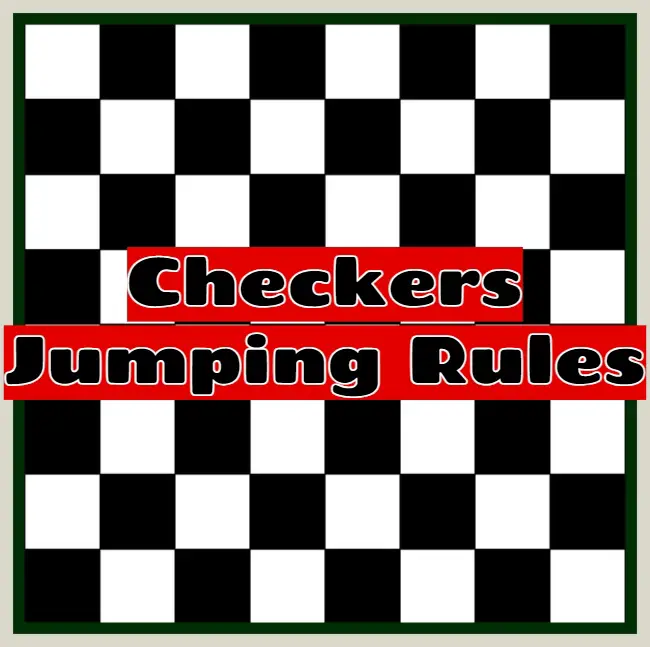
Although the rules of checkers are fairly simple, once your board is set up and you start playing, there are some questions that might arise. Most of these revolve around jumping.
These are the official jumping rules of checkers. Once you’re comfortable with the rules of checkers, you can learn how to improve your play with strategy and tactics.
Checkers Jumping Rules
Let’s take a look at some of the common checker jumping rule questions that come up. There’s no need to get into arguments with your friends anymore!
Can You Double or Triple Jump?
Yes. Double jumps and triple jumps are allowed and are a big part of winning the game. Giving up one piece to jump two, or two pieces to jump three will give you a big advantage.
One of the simplest ways to improve is to learn how to set up double and triple jumps. Instead of thoughtlessly exchanging pieces, be alert for weaknesses in your opponent’s formation. Often, coming out ahead on only one exchange can secure you the win.
This question leads into the next one, which is:
How Many Times Can You Jump?
You can jump as many times as the board position allows. As far as I know, the maximum possible jumps on a turn is nine. Of course, it’s very unlikely, if not impossible, the board would ever end up in the required position during a regular game.
The point is, you can keep jumping as long as a jump is there. Obviously, a king has more potential for longer jumps. Triple jumps aren’t uncommon and a quadruple jump is definitely in reach for most of us.
Can You Jump Backwards or Sideways?
Yes, but only with a king. Regular pieces can’t move or jump backwards. A king can also double jump or more backwards.
Technically, there is no sideways in checkers. You’ll always be moving or jumping diagonally forward or diagonally backward. If you alternate one with the other, you’ll essentially be jumping sideways. Again, only a king can do this.
You cannot jump directly sideways. This would involve covering three squares, including two white ones. Jumps, like regular moves, are always made diagonally.
Can You Jump Your Own Pieces?
No. There is no situation where you can jump your own pieces, not even if you can’t move. Not with a regular piece and not with a king. There are no special allowances for a king jumping one of its own regular pieces or a king jumping another friendly king.
Can You Jump a King?
Yes. Regular pieces and kings can both jump enemy kings. Regular pieces can only do this moving forward, as usual. Kings can jump enemy kings forwards, backwards or as part of a multiple jump. Kings have no special defensive ability against getting jumped.
Of course, their ability to move backwards allows you to move them away from a threat in a way that you couldn’t with a regular piece. But if a king is in position to be jumped, there’s nothing you can do.
Do You Have to Jump?
Yes. If it’s your turn to move and a jump is available, you have to make it, even if this puts you at a disadvantage.
At first glance, this might seem like it simplifies the game, but it actually makes it more complex.
Sometimes, making a mandatory jump will leave your pieces in a weak position. Your opponent might be able to respond by jumping two, three or even more of your pieces. For this reason, forced jumps are a big part of the tactics of checkers.
Always look at the possibilities that forced jumps present. If you can make your opponent jump you, it could set up a multiple jump for you.
Can You Land on the Same Square Twice?
Yes. When a king does a multiple jump, it’s possible it will land on the same square again. This isn’t likely to come up very often. I believe it takes a minimum of four jumps to get back to your initial square, and a minimum of five to land on a square twice.
Can You Jump the Same Piece Twice?
No. When a piece (or king) is jumped, it is effectively removed from the board, even if it’s not taken off immediately. So, if a jumping sequence brings you back to the same piece, it can’t be jumped again to keep the sequence going and allow you to jump another piece or to land on a different square. That piece was effectively removed from the board when it was first jumped, so it’s not really there to be jumped again.
Checkers Jumping Rules Summary
Here are the main checkers jumping rules to remember:
- Jumping is mandatory, including multiple jumps.
- Regular pieces can only jump diagonally forward.
- Kings can jump diagonally forward and diagonally backward.
- Regular pieces and kings can jump and can be jumped by both regular pieces and kings.
- You can’t jump your own pieces.
- Complete Checkers Rules
- Checkers overview
I hope this look at checkers jumping rules has answered your question.